Indiana State has Bird. Murray has Ja. Why isn't UE's Sloan as revered a figure in hoops?
EVANSVILLE — The University of Evansville men’s basketball practice gym holds a history lesson on its walls. The five College Division national championships are listed out, as are the NCAA tournament appearances and postseason successes. Conference titles, the 2015 CIT championship and various runs of yesteryear decorate the cinder block walls that surround the polished floor.
Opposite of the listed teams and accomplishments and labeled in orange, the Purple Aces have some of their legendary names listed with their retired jersey numbers, the same that hang in the rafters at Ford Center. From left to right, they read: Head Coach JIM CREWS, Head Coach ARAD McCUTCHAN, 5 MARCUS WILSON, 31 ANDY ELKINS, 20 SCOTT SHREFFLER, 3 SCOTT HAFFNER, 50 MARTY SIMMONS, 15 BRAD LEAF, 10 DON BUSE, 50 LARRY HUMES, one name that stands alone in legacy and recognition, 40 ED SMALLWOOD, 20 HUGH AHLERING and 19 GUS DOERNER.
The name sandwiched between Humes and Smallwood is one that transcends UE and the sport in general: 52 JERRY SLOAN.
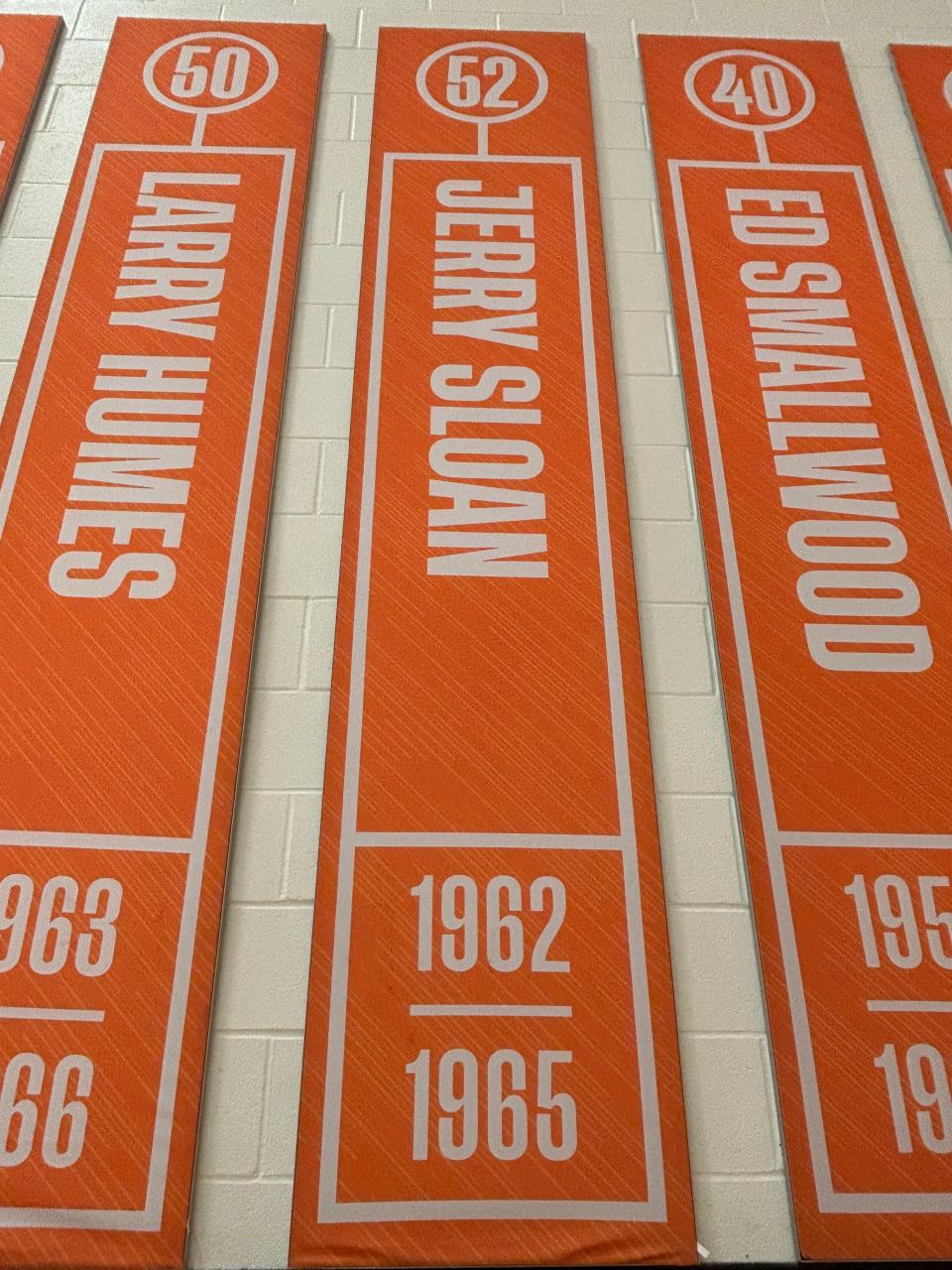
Sloan’s is the one that catches the eyes of visitors and recruits who pass through the hallowed halls, many of whom weren’t aware of his collegiate allegiance. They are familiar with Sloan’s famed NBA career. He was "The Original Bull," long before Michael Jordan, Scottie Pippen and Dennis Rodman patrolled Chicago. Sloan guided the Utah Jazz to two Western Conference titles over his two-decade coaching career. His No. 4 jersey, like his 52 in Evansville, hangs in the Windy City rafters, as does a 1223 banner representing his wins in Salt Lake. Sloan was inducted into the Naismith Memorial Basketball Hall of Fame in 2009 and passed away in 2020.
He was taken with the fourth-overall pick in the 1965 NBA Draft by the Baltimore Bullets after leading the Purple Aces to two national championships. Many, though, don’t know of Sloan’s pre-professional days spent dominating College Division men’s basketball and donning the Aces jersey.
“Him going to school here was a pivotal time for our program,” current coach David Ragland said. “It is weird that more people don’t know it, first off. … Although it may not be well known, I thought Jerry Sloan always did a good job staying connected to the University of Evansville.”
When observing other similar schools, particularly in the Missouri Valley Conference, Sloan’s allegiance to the Aces isn’t front of mind for most. Many point to Larry Bird and his affiliation and legend status at Indiana State as the most obvious — “Every day, ‘When are we gonna get the next Larry Bird?’” Ragland recalled people asking him during his time with the Sycamores — or Ja Morant with Murray State as a more recent example.
No one, to his recollection, has asked Ragland about the next Sloan.
But Jerry Sloan’s name and legacy on the sport at large remain in the practice gym, Ford Center and the players’ lounge named in his honor. UE fans and die-hard college hoops fanatics may be aware, but it remains little known on a wider scale: Sloan was an Ace. And a damn good one at that.
“He was everything,” said Kenneth Lee, who was a sports information director at UE after Sloan’s graduation. “I was impressed with him. I think he was important, a very important player for the Aces, and his legacy lived on.”
Rick Smith: ‘I probably almost fainted’ when meeting Sloan
Rick Smith was being recruited by Arad McCutchan to play for UE. He didn’t need much of a sales pitch. He always wanted to play at Roberts Stadium, like his heroes in years gone by. He wanted to be an Ace, and McCutchan felt the same.
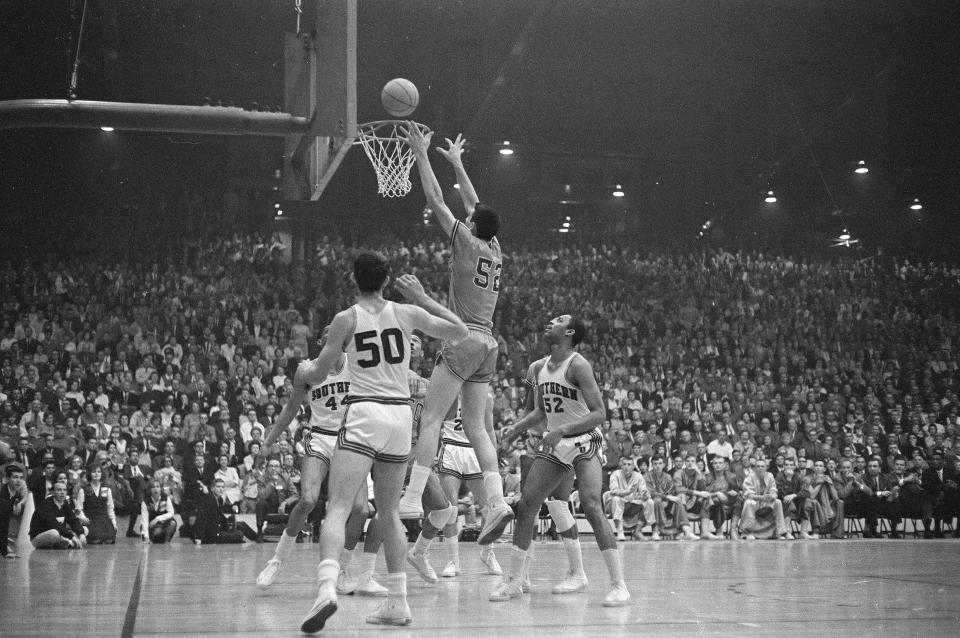
Smith and two teammates made the trip to Evansville from Oakland City on a Monday. He stepped into McCutchan’s office in Carson Center and was offered a scholarship right then and there, but he was asked to keep it quiet. McCutchan wanted to meet Smith’s parents that Friday, which resulted in a molasses-coated week of wait.
Friday came, and McCutchan walked through the front door with Gus Doerner and one more unexpected guest.
“I probably almost fainted when Jerry Sloan sticks out his big hand and introduces himself,” said Smith, who was a starting guard on UE’s 1971 title-winning team alongside Don Buse. “I’m going, ‘Oh my gosh. Jerry, you don’t have to introduce yourself to me.’
“I know I must’ve just sat there, probably starstruck.”
Smith accepted the scholarship that night. McCutchan made arrangements for Smith and his family to go to Evansville to sign the next week. The memory that stands the most, though, is Sloan’s giant paw extended to shake his, and what a moment it was.
“Jerry was just my hero. He was my idol,” Smith said. “He was definitely my inspiration. I was just overwhelmed when I was gonna be able to wear an Aces uniform.”
Smith, though he started after Sloan had gone, played pickup games against him and some other Aces. He played as hard as he could, “but Jerry, nobody played any harder,” he said. Sloan wasn’t the most physically or athletically gifted player but always worked more than anyone else.
He remembers watching Sloan with his father, getting a glimpse of what was to come.
“Watch Jerry on defense,” he told Smith. “Watch how he plays defense when his man does not have the ball.”
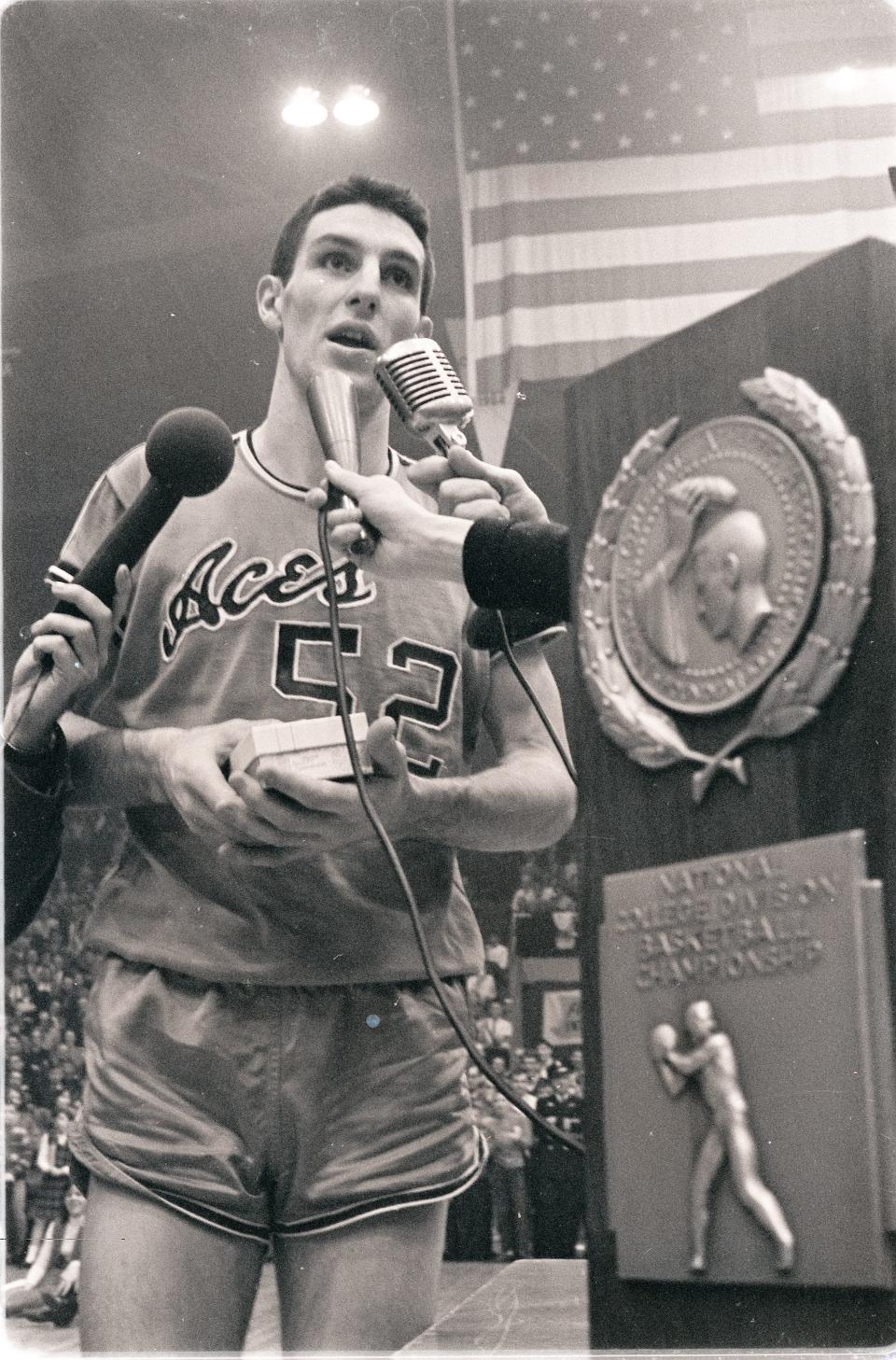
“That’s what really interested me and made me think that Jerry was more than somebody out there looking for a shot and looking to score points,” Smith said.
Smith and Sloan got to know each other. The future hall-of-famer was humble and down to earth, looking to perfect his craft to provide for his family. He wasn’t loud. Sloan didn’t want the accolades and pointed to others instead.
That was off the court.
Smith spent time with Sloan in the summer of 1967 when he was back taking classes at UE after he’d finished his second year in the league. Sloan was ferociously determined to get better. They played games over the heated months at Carson Center. Those introduced Smith to college basketball and the man he admired.
Unwilling to lose, Sloan’s “tenacity and elbows,” Smith said, showed him the next level.
“You walked on that court with Jerry Sloan, all friendship ended,” Smith said. “He intended to win every game that he played in.”
As much was to be expected of the man who went face-to-face with the likes of Wilt Chamberlain. That was Jerry Sloan and, to a certain degree, that was the University of Evansville. That competitiveness and drive led to two national titles and 1223 wins as an NBA coach.
“He wanted the game to be a rough-and-tumble game,” Smith said. “Jerry was out to make a living and he never made any bones about it. He had a wife and a child before he ever left the University of Evansville. He was the man of the house; he had to support his family. … He was gonna have to keep his spot in the NBA.”
Ragland: ‘Legends live on forever’
Indiana State coach Josh Schertz, like Ragland, has become accustomed to the constant Bird-mania of Terre Haute. Not that Larry ever wanted it that way. He was a competitor and wanted to be the best, known for his game and trash talk, but was never one to soak in the spotlight, much like Sloan.
Bird and Sloan went down a similar path despite their collegiate careers being over a decade apart. Neither basked in their own glory; both were tangent competitors; neither sought the spotlight; both were serial winners.
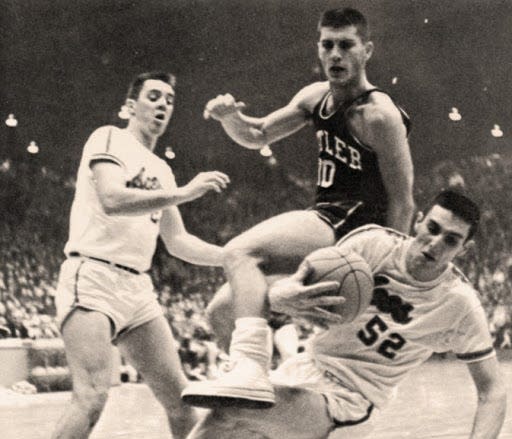
Schertz tells his recruits the same things: They’ll never have to be ISU’s best player because of Bird and he’ll never have to be ISU’s best coach because of John Wooden. He does, though, wonder about the shelf life of those pitches. At what point do they become stale?
“Kids are still young. A lot of them obviously have never seen them play,” Schertz said. “For some reason, it still carries weight. … Those things are all part of Indiana State’s tradition and history.”
He said he’s been pleasantly surprised by the amount of recruits who are still drawn to Bird. “He’s been retired for 15 years before they were even born,” Schertz said. But still, kids take pictures with the statue outside Hulman Center and wear 33 in honor of the ‘Hick from French Lick.’ Ja Morant’s celebrity and status does much of the same at Murray State.
“There’ll be a point where it won’t resonate the same way,” Schertz said. “The fact (Bird) played here, that he did what he did and the team did what they did, man, that for us is part of it. … It’ll minimize a little bit, but as of now, that’s a huge part of our sell.”
Ragland pointed to some of that in current players. Modern college athletes point to LeBron James or Stephen Curry as the greatest player ever whereas people in Ragland’s or Schertz’s age would point to Jordan, Bird or Magic Johnson. Shelf life may be part of Sloan’s lack of current limelight.
“That’s special, and special doesn’t happen all the time,” Ragland said of Bird and Sloan at their respective schools. “I do feel like both of them, for what they’ve done at both places, should always be remembered, known and talked about.
“There’s a shelf life, but legends live on forever.
“It is weird that more people don’t know it. … A lot of people are like, ‘Jerry Sloan went to school here?’ To me, it’s kind of a wild question, but I think we’ll get here.”
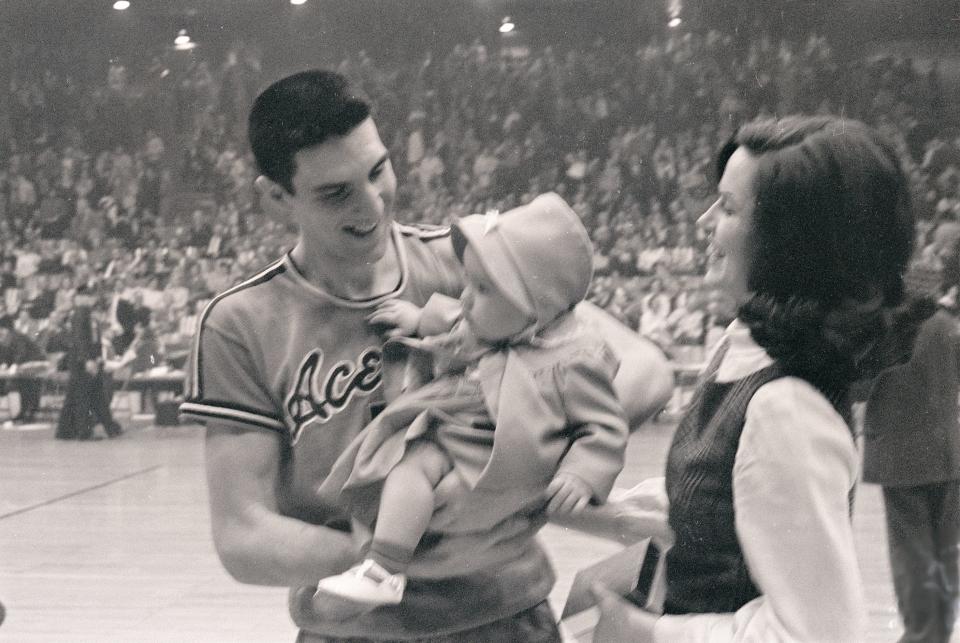
Smith feels that some history took a backseat when UE made the Division I jump. He and his teammates maintain a strong distinction between what was the former College Division and what is now Division II — “As long as we are alive, we will battle,” he said with a laugh. He said people don’t recognize the D-II label as the “big-time basketball” that UE was in his day.
“I have a younger daughter that, when I finally pass away, she will probably still carry that torch,” Smith said.
“These guys could have played anywhere on any team in the country,” he said. “I will go to my grave tapping those players and the great teams to anybody that wants to listen.”
Ragland, Smith on the important of preserving history
Ragland has made connecting UE’s past to the present a focal point of his tenure. He hired Marcus Wilson, whose name stands eight spots to the left of Sloan’s on the wall, and Craig Snow as assistant coaches. Former Aces visit campus and the practice facility on a regular basis. Part of that is so history isn’t forgotten. Sloan is a crucial part of that. Not many schools can boast a hall-of-fame talent, let alone one of all-time status.
They’re working on a database of all the coaches and players who have been at UE and their time at the school so they can connect with them.
The past sells Ragland’s vision. Where the program has been, where it is and where he hopes to go. Players like Sloan were part of what got the Aces to that point and are an important part, in one way or another, of getting them back to competing.
“We use it in our recruiting. We talk about it; it’s part of our history,” Ragland said. “We want to create our own legacy, too, with the individuals that we’re recruiting.”
Smith has long taken an active part in preserving that history. He came into possession of the College Division championship banners and retired jerseys were taken down from the practice facility because of spacing. He has distributed some jerseys to the players’ families and proudly displayed some of the banners in his home for a while, though they are now kept in a safe place. He’s written an Aces history curriculum for the current staff.
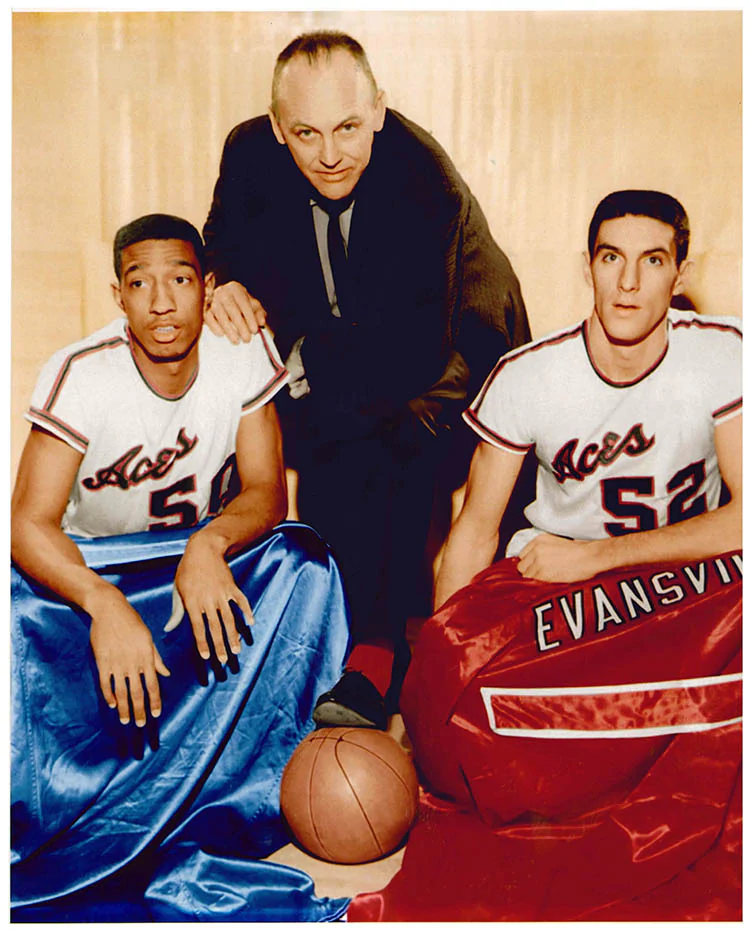
He thinks the past is important to preserve. That history holds UE’s success of which his hero, mentor and friend, Jerry Sloan, was a major part of.
“There just aren’t that many places on a small campus like the University of Evansville,” Smith said. “Unless the coaches talk about it, you just don’t see that many things about Jerry Sloan and the other greats on the campus.”
There in the facility, the name and number forever enshrined for future Aces and passerbys to see, sandwiched between Ed Smallwood and Larry Humes, a transcendental figure, mentioned widely or not, will remain.
52 JERRY SLOAN.
This article originally appeared on Evansville Courier & Press: Evansville Purple Aces: Jerry Sloan's UE legacy

